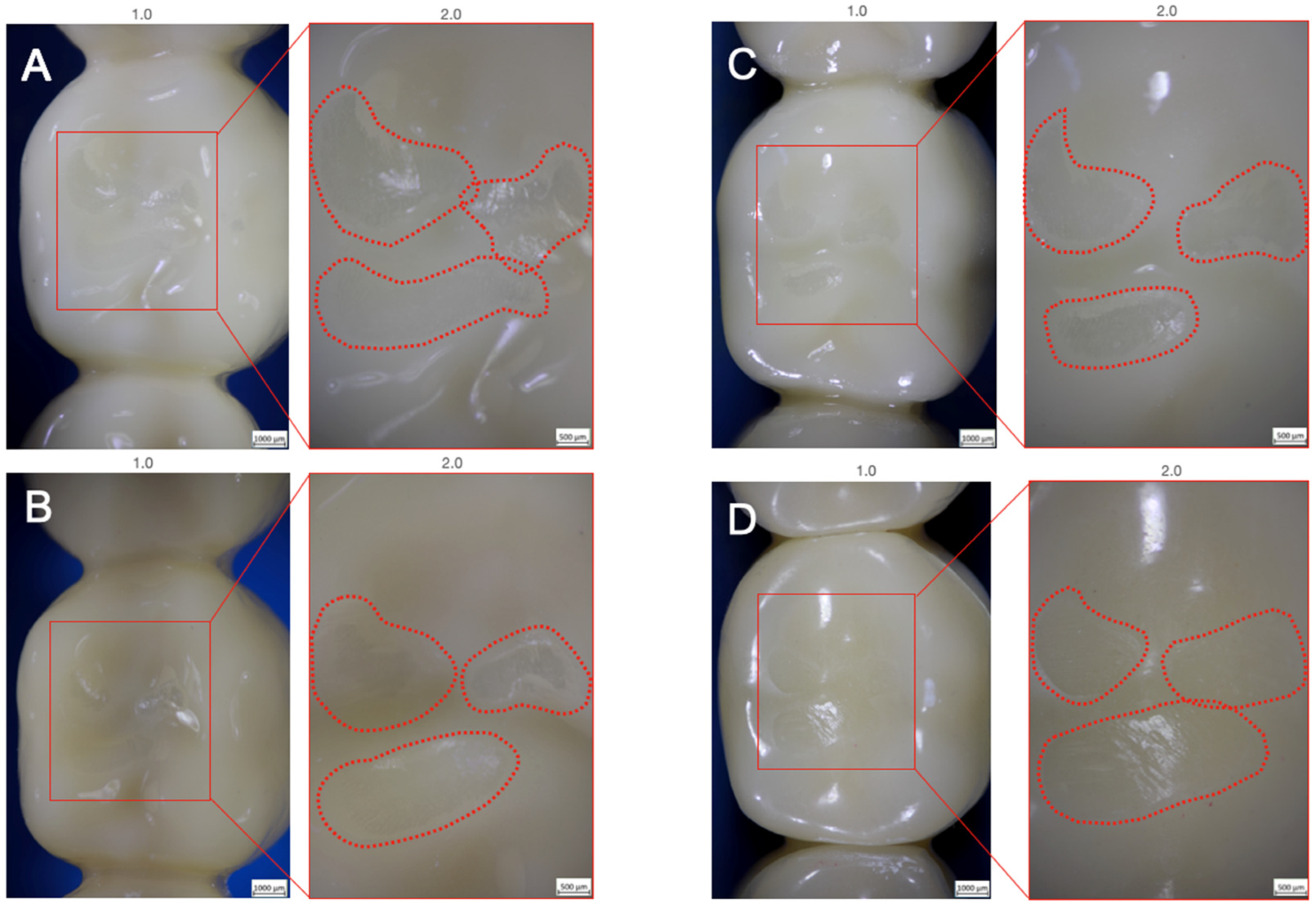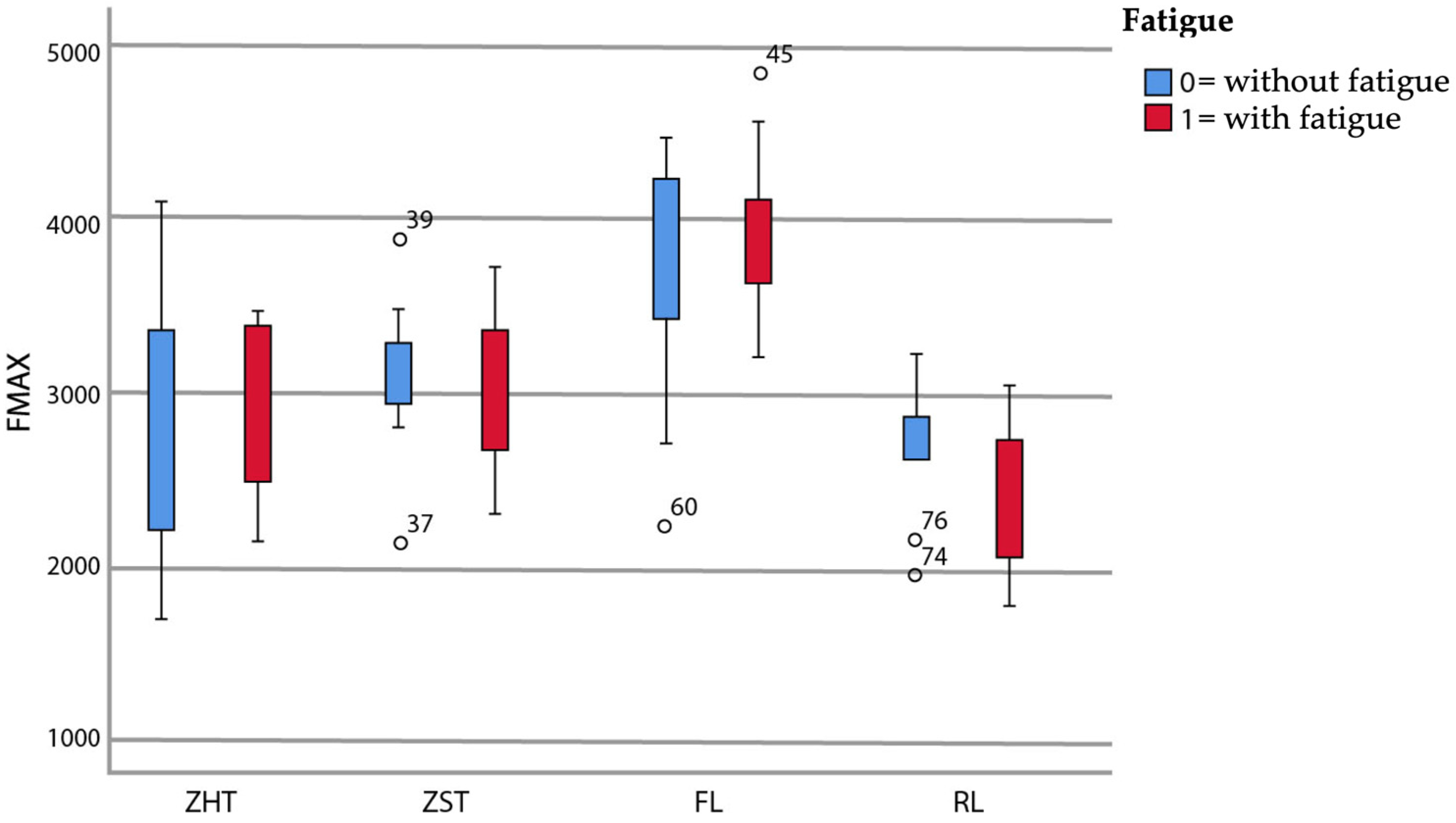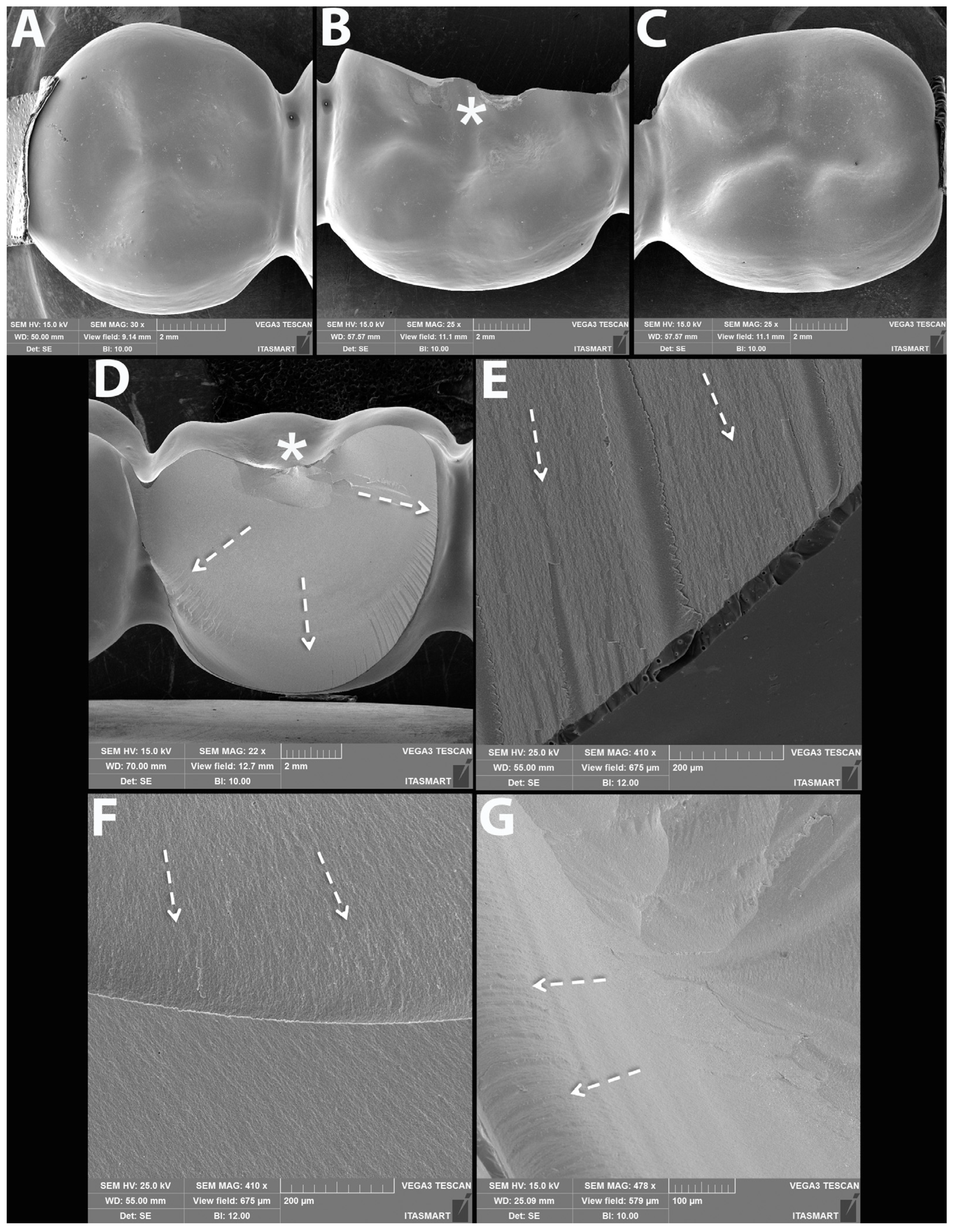Failure Load and Fatigue Behavior of Monolithic and Bi-Layer Zirconia Fixed Dental Prostheses Bonded to One-Piece Zirconia Implants
Abstract
1. Introduction
2. Materials and Methods
- Group Z-HT: monolithic 3Y-TZP zirconia FDP (Vita YZ-HT, Vita Zahnfabrik, Bad Säckingen, Germany)
- Group Z-ST: monolithic 4Y-TZP zirconia FDP (Vita YZ-ST, Vita Zahnfabrik)
- Group FL: 3Y-TZP zirconia FDP (Vita YZ-HT, Vita Zahnfabrik) with facial veneer (Feldspathic porcelain: Vita VM9, Vita Zahnfabrik)
- Group RL: polymer-infiltrated ceramic network (PICN Vita Enamic, Vita Zahnfabrik) “tabletop” resin bonded to a 3Y-TZP zirconia framework (Vita YZ-HT, Vita Zahnfabrik)
2.1. Fabrication of Implant Crowns
2.2. Preparation of Specimens
2.3. Adhesive Cementation
2.4. Fatigue Analysis
2.5. Single Load to Failure (SLF)
2.6. Fractographic Analysis
2.7. Statistical Analysis
3. Results
3.1. Cyclic Loading
3.2. Single Load to Failure
3.3. Failure and Fractographic Analysis after Single Load to Failure Testing
4. Discussion
5. Conclusions
- The applied fatigue protocol had no effect on the failure load of the materials investigated.
- All tested prosthetic reconstructions showed higher failure loads (>2384 N) than normal physiological occlusal forces (200–900 N) in the posterior region and can be used clinically.
- Bi-Layer FL and monolithic Z-ST showed the highest resilience and might serve as reliable prosthetic reconstruction concepts for 3-unit FDPs on ceramic implants.
- The Rapid-Layer concept shifted failure modes from catastrophic bulk fractures to clinically repairable failures within the PICN veneer layer.
- The proposed rapid-layer design with a PICN “tabletop” might be an interesting restorative treatment concept for zirconia implants due to their tooth-like wear behavior and easy replaceability.
- Proper veneer design with a limited extension to the buccal/facial area resulted in superior failure load results.
- Future research should focus on novel strength-gradient multilayer zirconia ceramics for SCs and FDPs on one- and two-piece ceramic implants.
Author Contributions
Funding
Institutional Review Board Statement
Informed Consent Statement
Data Availability Statement
Acknowledgments
Conflicts of Interest
References
- Gracis, S.; Thompson, V.P.; Ferencz, J.L.; Silva, N.R.; Bonfante, E.A. A new classification system for all-ceramic and ceramic-like restorative materials. Int. J. Prosthodont. 2015, 28, 227–235. [Google Scholar] [CrossRef]
- Zhang, Y.; Lawn, B.R. Novel Zirconia Materials in Dentistry. J. Dent. Res. 2018, 97, 140–147. [Google Scholar] [CrossRef]
- Baltatu, M.S.; Vizureanu, P.; Sandu, A.V.; Florido-Suarez, N.; Saceleanu, M.V.; Mirza-Rosca, J.C. New Titanium Alloys, Promising Materials for Medical Devices. Materials 2021, 14, 5934. [Google Scholar] [CrossRef]
- Webber, L.P.; Wang, H.-L. Will Zirconia Implants Replace Titanium Implants? Appl. Sci. 2021, 11, 6776. [Google Scholar] [CrossRef]
- Thoma, D.S.; Gil, A.; Hämmerle, C.H.F.; Jung, R.E. Management and prevention of soft tissue complications in implant dentistry. Periodontol 2000 2022, 88, 116–129. [Google Scholar] [CrossRef] [PubMed]
- Kniha, K.; Kniha, H.; Grunert, I.; Edelhoff, D.; Hölzle, F.; Modabber, A. Esthetic evaluation of maxillary single-tooth zirconia implants in the esthetic zone. Int. J. Periodontics Restor. Dent. 2019, 39, e195–e201. [Google Scholar] [CrossRef] [PubMed]
- Roehling, S.; Schlegel, K.A.; Woelfler, H.; Gahlert, M. Zirconia compared to titanium dental implants in preclinical studies-A systematic review and meta-analysis. Clin. Oral. Implant. Res. 2019, 30, 365–395. [Google Scholar] [CrossRef]
- Rohr, N.; Hoda, B.; Fischer, J. Surface Structure of Zirconia Implants: An Integrative Review Comparing Clinical Results with Preclinical and In Vitro Data. Materials 2022, 15, 3664. [Google Scholar] [CrossRef]
- Roehling, S.; Gahlert, M.; Janner, S.; Meng, B.; Woelfler, H.; Cochran, D.L. Ligature-Induced Peri-implant Bone Loss Around Loaded Zirconia and Titanium Implants. Int. J. Oral. Maxillofac. Implant. 2019, 34, 357–365. [Google Scholar] [CrossRef]
- Clever, K.; Schlegel, K.A.; Kniha, H.; Conrads, G.; Rink, L.; Modabber, A.; Holzle, F.; Kniha, K. Experimental peri-implant mucositis around titanium and zirconia implants in comparison to a natural tooth: Part 2-clinical and microbiological parameters. Int. J. Oral. Maxillofac. Surg. 2019, 48, 560–565. [Google Scholar] [CrossRef]
- Bienz, S.P.; Hilbe, M.; Husler, J.; Thoma, D.S.; Hammerle, C.H.F.; Jung, R.E. Clinical and histological comparison of the soft tissue morphology between zirconia and titanium dental implants under healthy and experimental mucositis conditions-A randomized controlled clinical trial. J. Clin. Periodontol. 2021, 48, 721–733. [Google Scholar] [CrossRef]
- Balmer, M.; Spies, B.C.; Kohal, R.J.; Hämmerle, C.H.; Vach, K.; Jung, R.E. Zirconia implants restored with single crowns or fixed dental prostheses: 5-year results of a prospective cohort investigation. Clin. Oral. Implant. Res. 2020, 31, 452–462. [Google Scholar] [CrossRef] [PubMed]
- Kohal, R.J.; Spies, B.C.; Vach, K.; Balmer, M.; Pieralli, S. A Prospective Clinical Cohort Investigation on Zirconia Implants: 5-Year Results. J. Clin. Med. 2020, 9, 2585. [Google Scholar] [CrossRef]
- Gahlert, M.; Kniha, H.; Laval, S.; Gellrich, N.C.; Bormann, K.H. Prospective Clinical Multicenter Study Evaluating the 5-Year Performance of Zirconia Implants in Single-Tooth Gaps. Int. J. Oral. Maxillofac. Implant. 2022, 37, 804–811. [Google Scholar] [CrossRef] [PubMed]
- Roehling, S.; Schlegel, K.A.; Woelfler, H.; Gahlert, M. Performance and outcome of zirconia dental implants in clinical studies: A meta-analysis. Clin. Oral. Implant. Res. 2018, 29, 135–153. [Google Scholar] [CrossRef]
- Spitznagel, F.A.; Balmer, M.; Wiedemeier, D.B.; Jung, R.E.; Gierthmuehlen, P.C. Clinical outcomes of all-ceramic single crowns and fixed dental prostheses supported by ceramic implants: A systematic review and meta-analyses. Clin. Oral. Implant. Res. 2022, 33, 1–20. [Google Scholar] [CrossRef]
- Sailer, I.; Strasding, M.; Valente, N.A.; Zwahlen, M.; Liu, S.; Pjetursson, B.E. A systematic review of the survival and complication rates of zirconia-ceramic and metal-ceramic multiple-unit fixed dental prostheses. Clin. Oral. Implant. Res. 2018, 29 (Suppl. 16), 184–198. [Google Scholar] [CrossRef]
- Pjetursson, B.E.; Sailer, I.; Latyshev, A.; Rabel, K.; Kohal, R.J.; Karasan, D. A systematic review and meta-analysis evaluating the survival, the failure, and the complication rates of veneered and monolithic all-ceramic implant-supported single crowns. Clin. Oral. Implant. Res. 2021, 32 (Suppl. 21), 254–288. [Google Scholar] [CrossRef]
- Zhang, F.; Inokoshi, M.; Batuk, M.; Hadermann, J.; Naert, I.; Van Meerbeek, B.; Vleugels, J. Strength, toughness and aging stability of highly-translucent Y-TZP ceramics for dental restorations. Dent. Mater. 2016, 32, e327–e337. [Google Scholar] [CrossRef]
- Blatz, M.B.; Vonderheide, M.; Conejo, J. The Effect of Resin Bonding on Long-Term Success of High-Strength Ceramics. J. Dent. Res. 2018, 97, 132–139. [Google Scholar] [CrossRef]
- Sorrentino, R.; Ruggiero, G.; Di Mauro, M.I.; Breschi, L.; Leuci, S.; Zarone, F. Optical behaviors, surface treatment, adhesion, and clinical indications of zirconia-reinforced lithium silicate (ZLS): A narrative review. J. Dent. 2021, 112, 103722. [Google Scholar] [CrossRef] [PubMed]
- Alammar, A.; Blatz, M.B. The resin bond to high-translucent zirconia-A systematic review. J. Esthet. Restor. Dent. 2022, 34, 117–135. [Google Scholar] [CrossRef] [PubMed]
- Lopes, G.R.S.; Ramos, N.C.; Grangeiro, M.T.V.; Matos, J.D.M.; Bottino, M.A.; Ozcan, M.; Valandro, L.F.; Melo, R.M. Adhesion between zirconia and resin cement: A critical evaluation of testing methodologies. J. Mech. Behav. Biomed. Mater. 2021, 120, 104547. [Google Scholar] [CrossRef] [PubMed]
- Nakonieczny, D.S.; Kern, F.; Dufner, L.; Dubiel, A.; Antonowicz, M.; Matus, K. Effect of Calcination Temperature on the Phase Composition, Morphology, and Thermal Properties of ZrO2 and Al2O3 Modified with APTES (3-aminopropyltriethoxysilane). Materials 2021, 14, 6651. [Google Scholar] [CrossRef]
- Kolakarnprasert, N.; Kaizer, M.R.; Kim, D.K.; Zhang, Y. New multi-layered zirconias: Composition, microstructure and translucency. Dent. Mater. 2019, 35, 797–806. [Google Scholar] [CrossRef]
- Michailova, M.; Elsayed, A.; Fabel, G.; Edelhoff, D.; Zylla, I.M.; Stawarczyk, B. Comparison between novel strength-gradient and color-gradient multilayered zirconia using conventional and high-speed sintering. J. Mech. Behav. Biomed. Mater. 2020, 111, 103977. [Google Scholar] [CrossRef] [PubMed]
- Nueesch, R.; Martin, S.; Rohr, N.; Fischer, J. In Vitro Investigations in a Biomimetic Approach to Restore One-Piece Zirconia Implants. Materials 2021, 14, 4361. [Google Scholar] [CrossRef] [PubMed]
- Spitznagel, F.A.; Röhrig, S.; Langner, R.; Gierthmuehlen, P.C. Failure Load and Fatigue Behavior of Monolithic Translucent Zirconia, PICN and Rapid-Layer Posterior Single Crowns on Zirconia Implants. Materials 2021, 14, 1990. [Google Scholar] [CrossRef] [PubMed]
- Schweiger, J.; Neumeier, P.; Stimmelmayr, M.; Beuer, F.; Edelhoff, D. Macro-retentive replaceable veneers on crowns and fixed dental prostheses: A new approach in implant-prosthodontics. Quintessence Int. 2013, 44, 341–349. [Google Scholar] [CrossRef]
- Rho, J.Y.; Ashman, R.B.; Turner, C.H. Young’s modulus of trabecular and cortical bone material: Ultrasonic and microtensile measurements. J. Biomech. 1993, 26, 111–119. [Google Scholar] [CrossRef]
- Ashman, R.B.; Rho, J.Y. Elastic modulus of trabecular bone material. J. Biomech. 1988, 21, 177–181. [Google Scholar] [CrossRef] [PubMed]
- Pieralli, S.; Kohal, R.J.; Jung, R.E.; Vach, K.; Spies, B.C. Clinical Outcomes of Zirconia Dental Implants: A Systematic Review. J. Dent. Res. 2017, 96, 38–46. [Google Scholar] [CrossRef] [PubMed]
- Blumer, L.; Schmidli, F.; Weiger, R.; Fischer, J. A systematic approach to standardize artificial aging of resin composite cements. Dent. Mater. 2015, 31, 855–863. [Google Scholar] [CrossRef] [PubMed]
- Kern, M.; Strub, J.R.; Lu, X.Y. Wear of composite resin veneering materials in a dual-axis chewing simulator. J. Oral. Rehabil. 1999, 26, 372–378. [Google Scholar] [CrossRef] [PubMed]
- Delong, R.; Sakaguchi, R.L.; Douglas, W.H.; Pintado, M.R. The wear of dental amlgam in an artifical mouth: A clinical correlation. Dent. Mater. 1985, 1, 238–242. [Google Scholar] [CrossRef]
- Rosentritt, M.; Behr, M.; van der Zel, J.M.; Feilzer, A.J. Approach for valuating the influence of laboratory simulation. Dent. Mater. 2009, 25, 348–352. [Google Scholar] [CrossRef]
- Mainjot, A.K.; Dupont, N.M.; Oudkerk, J.C.; Dewael, T.Y.; Sadoun, M.J. From Artisanal to CAD-CAM Blocks: State of the Art of Indirect Composites. J. Dent. Res. 2016, 95, 487–495. [Google Scholar] [CrossRef]
- Schweiger, J.; Edelhoff, D.; Guth, J.F. 3D Printing in Digital Prosthetic Dentistry: An Overview of Recent Developments in Additive Manufacturing. J. Clin. Med. 2021, 10, 2010. [Google Scholar] [CrossRef]
- Varga, S.; Spalj, S.; Lapter Varga, M.; Anic Milosevic, S.; Mestrovic, S.; Slaj, M. Maximum voluntary molar bite force in subjects with normal occlusion. Eur. J. Orthod. 2011, 33, 427–433. [Google Scholar] [CrossRef]
- Bonfante, E.A.; Coelho, P.G.; Navarro, J.M., Jr.; Pegoraro, L.F.; Bonfante, G.; Thompson, V.P.; Silva, N.R.F.A. Reliability and failure modes of implant-supported Y-TZP and MCR three-unit bridges. Clin. Implant. Dent. Relat. Res. 2010, 12, 235–243. [Google Scholar] [CrossRef]
- Nazari, V.; Ghodsi, S.; Alikhasi, M.; Sahebi, M.; Shamshiri, A.R. Fracture Strength of Three-Unit Implant Supported Fixed Partial Dentures with Excessive Crown Height Fabricated from Different Materials. J. Dent. 2016, 13, 400–406. [Google Scholar]
- Alkharrat, A.R.; Schmitter, M.; Rues, S.; Rammelsberg, P. Fracture behavior of all-ceramic, implant-supported, and tooth-implant-supported fixed dental prostheses. Clin. Oral. Investig. 2018, 22, 1663–1673. [Google Scholar] [CrossRef]
- Kondo, T.; Komine, F.; Honda, J.; Takata, H.; Moriya, Y. Effect of veneering materials on fracture loads of implant-supported zirconia molar fixed dental prostheses. J. Prosthodont. Res. 2019, 63, 140–144. [Google Scholar] [CrossRef]
- Stimmelmayr, M.; Groesser, J.; Beuer, F.; Erdelt, K.; Krennmair, G.; Sachs, C.; Edelhoff, D.; Guth, J.F. Accuracy and mechanical performance of passivated and conventional fabricated 3-unit fixed dental prosthesis on multi-unit abutments. J. Prosthodont. Res. 2017, 61, 403–411. [Google Scholar] [CrossRef]
- Rayyan, M.M.; Abdallah, J.; Segaan, L.G.; Bonfante, E.A.; Osman, E. Static and Fatigue Loading of Veneered Implant-Supported Fixed Dental Prostheses. J. Prosthodont. 2020, 29, 679–685. [Google Scholar] [CrossRef]
- Tholey, M.J.; Swain, M.V.; Thiel, N. SEM observations of porcelain Y-TZP interface. Dent. Mater. 2009, 25, 857–862. [Google Scholar] [CrossRef]
- Rodrigues, C.D.S.; Aurelio, I.L.; Kaizer, M.D.R.; Zhang, Y.; May, L.G. Do thermal treatments affect the mechanical behavior of porcelain-veneered zirconia? A systematic review and meta-analysis. Dent. Mater. 2019, 35, 807–817. [Google Scholar] [CrossRef]
- Hensel, J.; Reise, M.; Liebermann, A.; Buser, R.; Stawarczyk, B. Impact of multiple firings on fracture load of veneered zirconia restorations. J. Mech. Behav. Biomed. Mater. 2022, 130, 105213. [Google Scholar] [CrossRef]
- Derksen, W.; Tahmaseb, A.; Wismeijer, D. Randomized Clinical Trial comparing clinical adjustment times of CAD/CAM screw-retained posterior crowns on ti-base abutments created with digital or conventional impressions. One-year follow-up. Clin. Oral. Implant. Res. 2021, 32, 962–970. [Google Scholar] [CrossRef]
- Di Fiore, A.; Granata, S.; Monaco, C.; Stellini, E.; Yilmaz, B. Clinical performance of posterior monolithic zirconia implant-supported fixed dental prostheses with angulated screw channels: A 3-year prospective cohort study. J. Prosthet. Dent. 2021, in press. [CrossRef]
- Balmer, M.; Payer, M.; Kohal, R.J.; Spies, B.C. EAO Position Paper: Current Level of Evidence Regarding Zirconia Implants in Clinical Trials. Int. J. Prosthodont. 2022, 35, 560–566. [Google Scholar] [CrossRef]
- Swain, M.V.; Coldea, A.; Bilkhair, A.; Guess, P.C. Interpenetrating network ceramic-resin composite dental restorative materials. Dent. Mater. 2016, 32, 34–42. [Google Scholar] [CrossRef]
- Rohr, N.; Nuesch, R.; Greune, R.; Mainetti, G.; Karlin, S.; Zaugg, L.K.; Zitzmann, N.U. Stability of Cantilever Fixed Dental Prostheses on Zirconia Implants. Materials 2022, 15, 3633. [Google Scholar] [CrossRef]
- Lardani, L.; Derchi, G.; Marchio, V.; Carli, E. One-Year Clinical Performance of Activa Bioactive-Restorative Composite in Primary Molars. Children 2022, 9, 433. [Google Scholar] [CrossRef]
- Melo, M.A.S.; Mokeem, L.; Sun, J. Bioactive Restorative Dental Materials-The New Frontier. Dent. Clin. North Am. 2022, 66, 551–566. [Google Scholar] [CrossRef]









| Group (n = 20) | FDP /Implant Design | Type | Name | Y2O3 [Weight%] | Flexural Strength [MPa] | Manufacturer |
|---|---|---|---|---|---|---|
| Z-HT | Monolithic FDP | 3Y-TZP Zirconia | Vita YZ HT | 4–6 | 1200 | Vita Zahnfabrik, Bad Säckingen, Germany |
| Z-ST | Monolithic FDP | 4Y-TZP Zirconia | Vita YZ ST | 6–8 | >850 | Vita Zahnfabrik, Bad Säckingen, Germany |
| FL | Bi-layer FDP | Feldspathic Veneer | VM9 | - | 100 | Vita Zahnfabrik, Bad Säckingen, Germany |
| 3Y-TZP Zirconia | Vita YZ HT | 4–6 | 1200 | |||
| RL | Rapid- Layer FDP | PICN | Vita Enamic | - | 150–160 | Vita Zahnfabrik, Bad Säckingen, Germany |
| 3Y-TZP Zirconia | Vita YZ HT | 4–6 | 1200 | |||
| All groups | One-piece Implant | 3Y-TZP Zirconia | ceramic. implant | 5 | 1400 | vitaclinical, Bad Säckingen, Germany |
| Zirconia FDP’s | Polymer-Infiltrated Ceramic Tabletop | Zirconia Implant | |
|---|---|---|---|
| Group | Z-HT, Z-ST, FL, RL (framework) | RL | All |
| Surface Pre-treatment | Air-particle abrasion with 50 μm Al2O3 at 2 bar, Ultrasonic cleaning with 70% ethanol for 3 min | Cleaning with 70% Ethanol, Etching with 5% hydrofluoric acid for 60 s (Vita Ceramics Etch, Vita Zahnfabrik), rinsed with air-water spray (30 s), ultrasonic cleaning with distilled water (5 min) | - |
| Primer | Clearfil Ceramic Primer Plus (Kuraray Noritake) | ||
| Resin Cement | Panavia V5 opaque (Kuraray Noritake) | ||
| Group | Without Fatigue | With Fatigue | Influence of Fatigue | |
|---|---|---|---|---|
| Mean ± SD | Mean ± SD | t-Value | p-Value | |
| Z-HT | 2899 ± 754 b | 2866 ± 509 B,C | 0.115 | 0.910 |
| Z-ST | 3138 ± 463 a,b | 3000 ± 460 B | 0.668 | 0.512 |
| FL | 3662 ± 723 a | 3923 ± 527 A | −0.922 | 0.369 |
| RL | 2654 ± 374 b | 2384 ± 438 C | 1.481 | 0.156 |
| Group | Z-HT | Z-ST | FL | RL | ||||
|---|---|---|---|---|---|---|---|---|
| Z-HT0 | Z-HT1 | Z-ST0 | Z-ST1 | FL0 | FL1 | RL0 | RL1 | |
| Bulk fracture within connector | 10/10 (100%) | 10/10 (100%) | 10/10 (100%) | 10/10 (100%) | 8/10 (80%) | 10/10 (100%) | 3/10 (30%) | 1/10 (10%) |
| Bulk fracture without connector | - | - | - | - | 2/10 (20%) | - | - | - |
| Chipping | - | - | - | - | - | - | 7/10 (70%) | 9/10 (90%) |
Publisher’s Note: MDPI stays neutral with regard to jurisdictional claims in published maps and institutional affiliations. |
© 2022 by the authors. Licensee MDPI, Basel, Switzerland. This article is an open access article distributed under the terms and conditions of the Creative Commons Attribution (CC BY) license (https://creativecommons.org/licenses/by/4.0/).
Share and Cite
Spitznagel, F.A.; Hoppe, J.S.; Bonfante, E.A.; Campos, T.M.B.; Langner, R.; Gierthmuehlen, P.C. Failure Load and Fatigue Behavior of Monolithic and Bi-Layer Zirconia Fixed Dental Prostheses Bonded to One-Piece Zirconia Implants. Materials 2022, 15, 8465. https://doi.org/10.3390/ma15238465
Spitznagel FA, Hoppe JS, Bonfante EA, Campos TMB, Langner R, Gierthmuehlen PC. Failure Load and Fatigue Behavior of Monolithic and Bi-Layer Zirconia Fixed Dental Prostheses Bonded to One-Piece Zirconia Implants. Materials. 2022; 15(23):8465. https://doi.org/10.3390/ma15238465
Chicago/Turabian StyleSpitznagel, Frank A., Johanna S. Hoppe, Estevam A. Bonfante, Tiago M. B. Campos, Robert Langner, and Petra C. Gierthmuehlen. 2022. "Failure Load and Fatigue Behavior of Monolithic and Bi-Layer Zirconia Fixed Dental Prostheses Bonded to One-Piece Zirconia Implants" Materials 15, no. 23: 8465. https://doi.org/10.3390/ma15238465
APA StyleSpitznagel, F. A., Hoppe, J. S., Bonfante, E. A., Campos, T. M. B., Langner, R., & Gierthmuehlen, P. C. (2022). Failure Load and Fatigue Behavior of Monolithic and Bi-Layer Zirconia Fixed Dental Prostheses Bonded to One-Piece Zirconia Implants. Materials, 15(23), 8465. https://doi.org/10.3390/ma15238465






